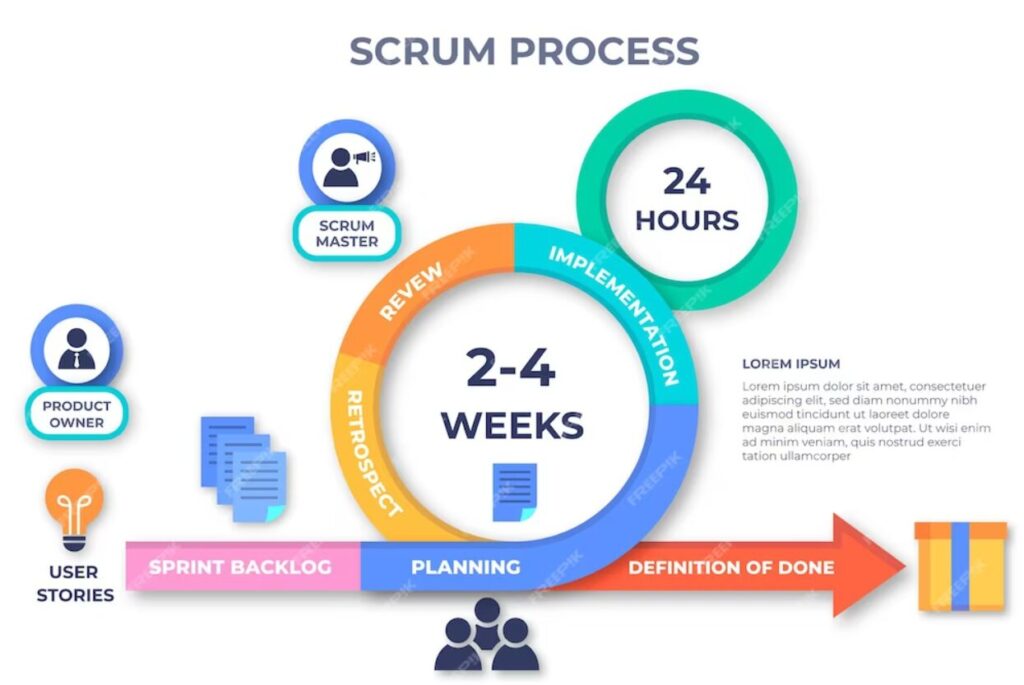Scrum process is a popular Agile framework for managing complex projects, primarily software development. It emphasizes iterative progress, collaboration, and flexibility, making it well suited for dynamic environments. This article explores the fundamentals of the Scrum process, its key roles, events, artifacts, and best practices.
What is Scrum?
Scrum is a framework within which people can address complex adaptive problems while productively and creatively delivering high value products. It is founded on empirical process control theory, or empiricism, which asserts that knowledge comes from experience and decision making based on what is known.

Key Roles in Scrum
Product Owner
- Responsibilities: Defines the features of the product, decides on release dates and content, and prioritizes features according to market value.
- Focus: Maximizing the value of the product and the work of the development team.
Scrum Master
- Responsibilities: Facilitates Scrum events, coaches the team on Scrum practices, and removes impediments.
- Focus: Ensuring the team follows Scrum practices and principles.
Development Team
- Responsibilities: Delivers a potentially shippable product increment at the end of each Sprint.
- Focus: Self organizing and cross functional, with all skills necessary to create a product increment.
Scrum Events
Sprint
- Duration: Typically 2-4 weeks.
- Purpose: A time boxed iteration to produce a potentially shippable product increment.
Sprint Planning
- Duration: 2 hours per week of Sprint duration.
- Purpose: Define what can be delivered in the Sprint and how the work will be achieved.
Daily Scrum
- Duration: 15 minutes.
- Purpose: Synchronize activities and create a plan for the next 24 hours.
Sprint Review
- Duration: 1 hour per week of Sprint duration.
- Purpose: Inspect the increment and adapt the product backlog if needed.
Sprint Retrospective
- Duration: 45 minutes per week of Sprint duration.
- Purpose: Reflect on the past Sprint and identify improvements for the next Sprint.
Scrum Artifacts
Product Backlog
- Description: An ordered list of everything that is known to be needed in the product.
- Management: Continuously updated and refined by the Product Owner.
Sprint Backlog
- Description: A list of tasks to be completed during the Sprint.
- Management: Managed by the Development Team.
Increment
- Description: The sum of all the Product Backlog items completed during a Sprint and all previous Sprints.
- Management: Presented during the Sprint Review.
Scrum Principles
Transparency
- Artifacts and processes must be visible to those responsible for the outcome.
Inspection
- Scrum users must frequently inspect Scrum artifacts and progress toward a Sprint goal to detect undesirable variances.
Adaptation
- If deviations occur, the process or material being worked on must be adjusted.
Best Practices in Scrum
Refinement and Grooming
- Regularly refine the Product Backlog to ensure clarity and readiness for future Sprints.
Continuous Collaboration
- Encourage constant communication between the Product Owner, Scrum Master, and Development Team.
Incremental Delivery
- Focus on delivering small, valuable increments rather than a complete product at once.
Embrace Change
- Welcome changing requirements, even late in development.
Focus on Quality
- Maintain a high standard of quality for every product increment.
Empower Teams
- Enable the Development Team to self-organize and make decisions.
At Enozom, we use the Scrum process to manage projects and develop software efficiently. Our teams work in short, focused cycles called Sprints, with regular meetings to plan, review progress, and improve. This approach helps us quickly adapt to changes and consistently deliver high quality products that meet our clients’ needs.
Conclusion
Scrum is a powerful framework that fosters collaboration, flexibility, and continuous improvement. By adhering to its roles, events, and artifacts, teams can effectively manage complex projects and deliver high value products. Embracing Scrum principles and best practices ensures that teams can respond to changes swiftly and efficiently, making it an ideal choice for dynamic and evolving project environments.
